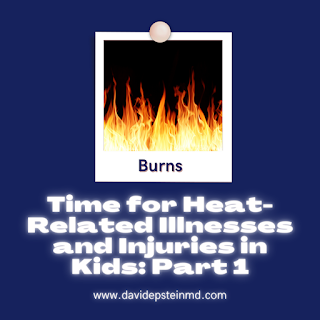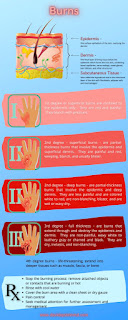We are coming to the time of the year when heat-related injuries and illnesses are more common. In the US, July 4th is celebrated with fireworks and barbecues. Also, the summer sun is at its peak intensity. So, there is a higher risk for burns, heatstroke, heat exhaustion, and dehydration. Understanding these heat-related injuries and illnesses is essential to better prevent them from occurring, especially in the pediatric population.
Burns can be caused by mechanisms that may include electricity, chemicals, radiation, and heat. Thermal or heat-related injuries, specifically, can be caused by things such as fire, hot liquids, radiant heat, and hot surfaces. While these sources seem obvious and should be easy to avoid, it is still surprising how kids get exposed to them. The most common circumstances under which we see burns in younger children, especially toddlers, are pulling hot liquids off a stove and onto themselves, being accidentally splashed with a cup of hot coffee or tea, or touching a hot iron or curling iron. These occurrences are very preventable, but young kids are so fast and curious that they may evade even the most defensive, child-proofing measures. Aside from literally playing with fire, older children and teens usually sustain mild to moderate burns from sun exposure. But, they do have their share of playing with fire, especially in the form of fireworks and just general, careless horseplay in the proximity of anything that is burning.
While there are a variety of methods of sustaining burns, the results are usually the same. The skin can be damaged in varying degrees of severity that is based on the depth of layers of skin involved. A first-degree burn is the mildest with just the superficial layer of skin (the epidermis) being injured. The skin is usually red and painful. It blanches with pressure. The second-degree burn is deeper and involves the epidermis and the dermis. The superficial, second-degree burn involves the epidermis and superficial dermis. It is usually red, painful, weeping, and blanches. Also, it will usually blister. The deep, second-degree burn involves the epidermis and deep dermis. It is less painful and is white to red in color. It blisters and has a wet or waxy, dry appearance. It is non-blanching and difficult to distinguish from full-thickness burns. The third-degree burn is more severe. It is a full-thickness burn and extends through and destroys the epidermis and dermis. It is usually not painful because the nerve endings in the dermis are destroyed by the burn. It has a waxy, white to leathery, gray or charred, black appearance. It is dry, inelastic, and non-blanching. Finally, the fourth-degree burn is the most severe and is life-threatening. It is a burn that extends into the deeper tissues like the muscle, fascia, or bone.
The consequences of a burn are dependent upon the severity of the burn and the total area of skin that is burned as well. While most fear the cosmetic consequences, there can be more life-threatening concerns with more severe burns. From a cosmetic and functional concern, usually, second-degree or worse burns are more apt to scar and may develop contractures. A skin contracture is a tightening of the skin by scar formation. This can be problematic because a contracture can limit the range of motion of joints, digits, and other movable body parts or can be quite disfiguring. Burns that involve the face, hands, feet, genitals, or a moving joint require particular attention because of the potential for disfigurement or loss of function. More life-threatening conditions arise with more severe burns and burns that cover a larger area because the skin acts as a barrier to prevent bacteria and other organisms from entering the body and from fluid leaving the body. So, more severe and larger area burns that significantly disrupt the integrity of the skin will predispose one to infection and dehydration.
While burn prevention is always the best medicine, burns still do occur. Initial treatment includes removing anything that is causing ongoing burning of the skin, cooling the skin with cool water, covering the burned area with dry gauze, and administering medication to control pain. If there is open skin from sloughing or blistering of the skin, antibiotic ointment or cream should be applied under the supervision of a medical professional. While first-degree burns are not overly concerning, more severe burns require further evaluation and management. If there is any concern or question about the severity of the burn or how to manage it, one should reach out to their primary care physician or the local urgent care, emergency department, or burn center.
What is your best piece of burn prevention advice that you can give parents? Please share your advice in the comments section!





Comments
Post a Comment